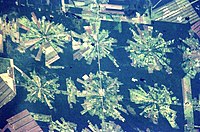
Photo from wikipedia
The hydrological properties of the clearcutting of forested catchments were widely investigated by analyzing runoff in the preand post-harvesting periods. Deforestation worldwide is primarily to meet the wood and fiber… Click to show full abstract
The hydrological properties of the clearcutting of forested catchments were widely investigated by analyzing runoff in the preand post-harvesting periods. Deforestation worldwide is primarily to meet the wood and fiber products demand for household and industry. It is a widely known phenomenon that deforestation enhances the streamflow and water yield. However, due to the complexity of forest structure and functions, little is known about the exact estimation of a percent increase in water yield after various harvesting intensities of conifers and broadleaved forest globally. To assess these effects, this study analyzed 145 catchments dataset collected from 21 publications. The study evaluates the influence of 25, 50, 75, and 100% deforestation on streamflow. Moreover, changes in the context of various variables like treatment years, elevation, area and mean annual precipitation were also analyzed. Overall comparison showed that after harvesting of broadleaved water yield increases up to 8-23% and in needle-leaved up to 9-28%. The study provides scientific insight into the essential role that annual precipitation, area, elevation, and year of treatment play in influencing hydrology. This research suggests that a target specific approach should be adopted in future forest management under the umbrella of integrated research to mitigate the challenges of climate change.
Journal Title: Applied Ecology and Environmental Research
Year Published: 2020
Link to full text (if available)
Share on Social Media: Sign Up to like & get
recommendations!